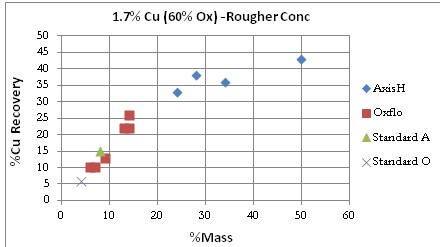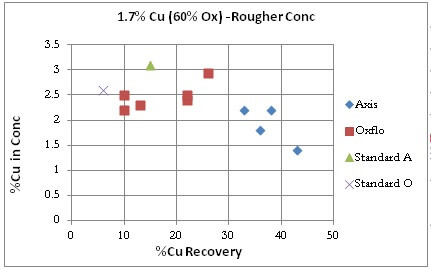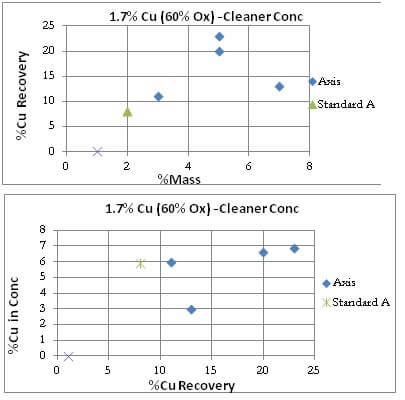In this flotation tests and evaluation for the best collector for copper oxide “ore” 911Metallurgy continues with material that’s 60% Oxide copper.
Sample C: 1.7% Copper about 60% Oxide Cu
Rougher Tests:
Both reagents appear to behave similarly as the “blue dots” are seemingly a continuation of the trend started by “red dots”. Oxflo and Axis show that the more %Mass you recover, the more the %Cu Recovery in increased.
Oxflo shows better Gold selectivity obtaining %Au Recoveries in the 20% at around 12% Mass while Axis needs 25% to 50% Mass to obtain around 15% Au Recovery.
The Oxflo and Axis collectors appear to have a similar selectivity towards Silver.
Axis obtained the best Ag Recoveries at around 30%. This good oxide flotation recovery was however associated with a large %Mass pull of 25% to 50% Oxflo was able to obtain almost 20% Ag Recovery at below 15% Mass.
Both reagents appear to on the same Grade/Recovery curve. “Blue dots” are seemingly a continuation of the trend started by “red dots”.
Cleaner Tests: This are Axis only data. No time was available for Oxflo to produce comparative data. Since both had similar Rougher flotation behaviors, we could speculate the Cleaner performance would also be similar.
The data and performance would likely stabilize with further testing.
Why is %Mass Recovery/Pull important
Comparing Hydroxamate Collectors
Compare Hydroxamate AM2 Rinkalore CTC3 Oxide Collectors
Flotation of oxide minerals is controlled by a number of factors, such as surface potential and solubility of the mineral, concentration and type of various inorganics, properties of the collector, pH, ionic strength and temperature. The role these factors play depends on the mechanisms of adsorption of the collector inorganics or polymer additives. The major mechanisms include electrostatic interactions, chemical adsorption, chain-chain interaction between adsorbed collector species and modifications of the surface by inorganics. In real systems, flotation is, however, markedly affected by various other processes, including aging of the minerals, surface precipitation of the collector on the mineral and associative interactions between various collector species leading to highly surface active, for example, monomolecular complexes. These effects arc reviewed here with selected examples.




